warning INFINITI Q40 2015 Towing Guide
[x] Cancel search | Manufacturer: INFINITI, Model Year: 2015, Model line: Q40, Model: INFINITI Q40 2015Pages: 25, PDF Size: 0.42 MB
Page 1 of 25
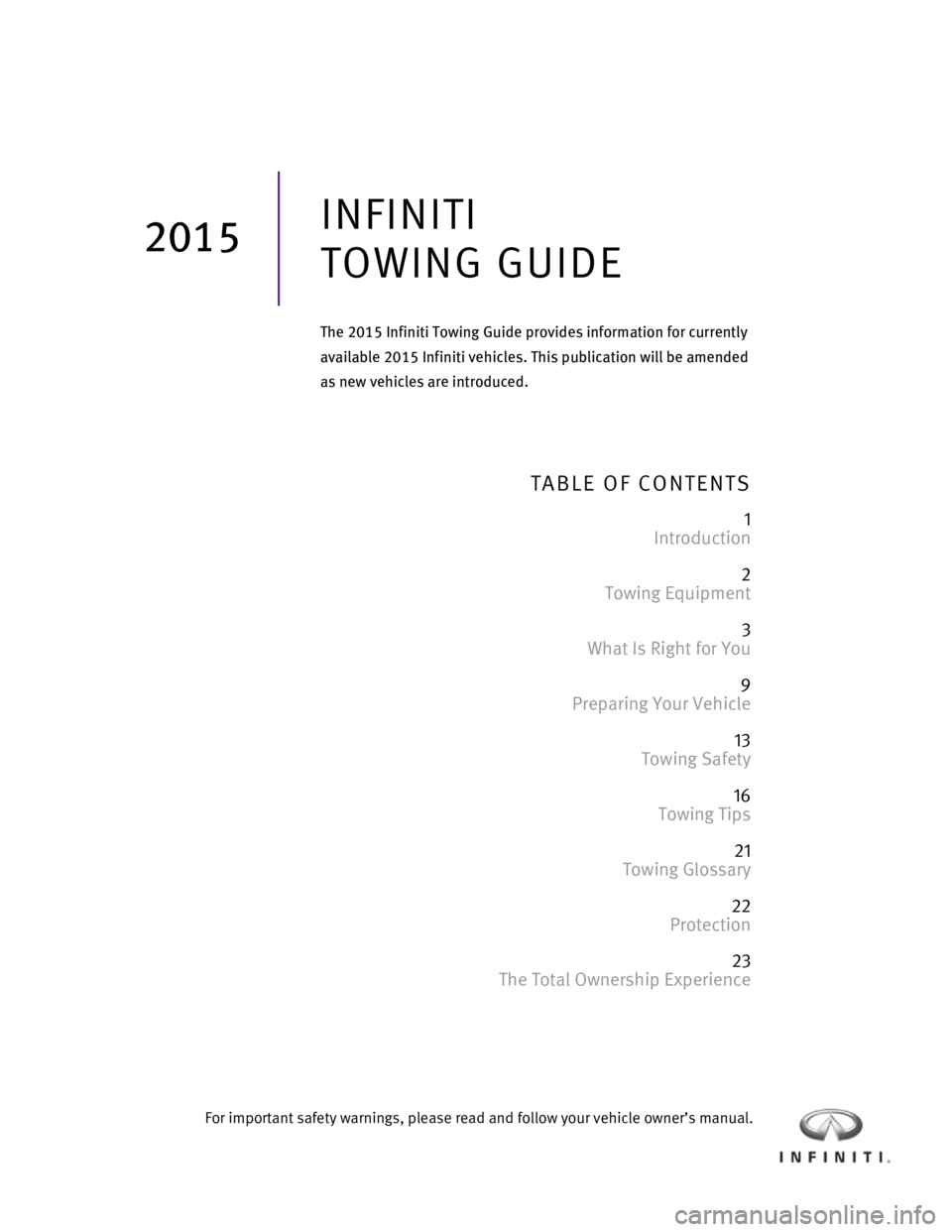
TABLE OF CONTENTS
1
Introduction
2
Towing Equipment
3
What Is Right for You
9
Preparing Your Vehicle
13
Towing Safety
16
Towing Tips
21
Towing Glossary
22
Protection
23
The Total Ownership Experience
INFINITI
TOWING GUIDE
The 2015 Infiniti Towing Guide provides information for currently
available 2015 Infiniti vehicles. This publication will be amended
as new vehicles are introduced.
2015
For important safety warnings, please read and follow your vehicle owner’s manual.
Page 3 of 25
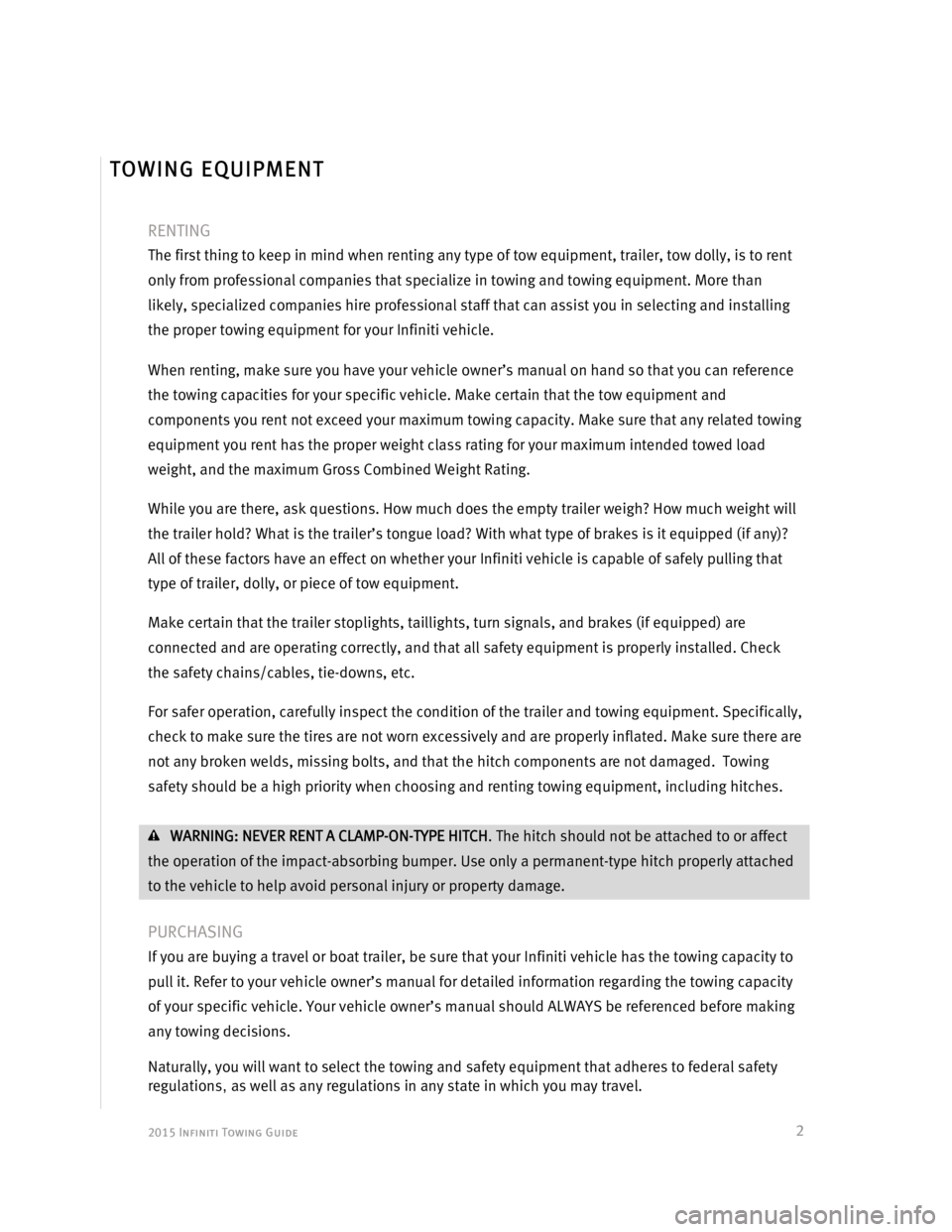
2015 Infiniti Towing Guide
2
RENTING
The first thing to keep in mind when renting any type of tow equipment, trailer, tow dolly, is to rent
only from professional companies that specialize in towing and towing equipment. More than
likely, specialized companies hire professional staff that can assist you in selecting and installing
the proper towing equipment for your Infiniti vehicle.
When renting, make sure you have your vehicle owner’s manual on hand so that you can reference
the towing capacities for your specific vehicle. Make certain that the tow equipment and
components you rent not exceed your maximum towing capacity. Make sure that any related towing
equipment you rent has the proper weight class rating for your maximum intended towed load
weight, and the maximum Gross Combined Weight Rating.
While you are there, ask questions. How much does the empty trailer weigh? How much weight will
the trailer hold? What is the trailer’s tongue load? With what type of brakes is it equipped (if any)?
All of these factors have an effect on whether your Infiniti vehicle is capable of safely pulling that
type of trailer, dolly, or piece of tow equipment.
Make certain that the trailer stoplights, taillights, turn signals, and brakes (if equipped) are
connected and are operating correctly, and that all safety equipment is properly installed. Check
the safety chains/cables, tie-downs, etc.
For safer operation, carefully inspect the condition of the trailer and towing equipment. Specifically,
check to make sure the tires are not worn excessively and are properly inflated. Make sure there are
not any broken welds, missing bolts, and that the hitch components are not damaged. Towing
safety should be a high priority when choosing and renting towing equipment, including hitches.
WARNING: NEVER RENT A CLAMP-ON-TYPE HITCH. The hitch should not be attached to or affect
the operation of the impact-absorbing bumper. Use only a permanent-type hitch properly attached
to the vehicle to help avoid personal injury or property damage.
PURCHASING
If you are buying a travel or boat trailer, be sure that your Infiniti vehicle has the towing capacity to
pull it. Refer to your vehicle owner’s manual for detailed information regarding the towing capacity
of your specific vehicle. Your vehicle owner’s manual should ALWAYS be referenced before making
any towing decisions.
Naturally, you will want to select the towing and safety equipment that adheres to federal safety
regulations, as well as any regulations in any state in which you may travel.
TOWING EQUIPMENT
Page 4 of 25
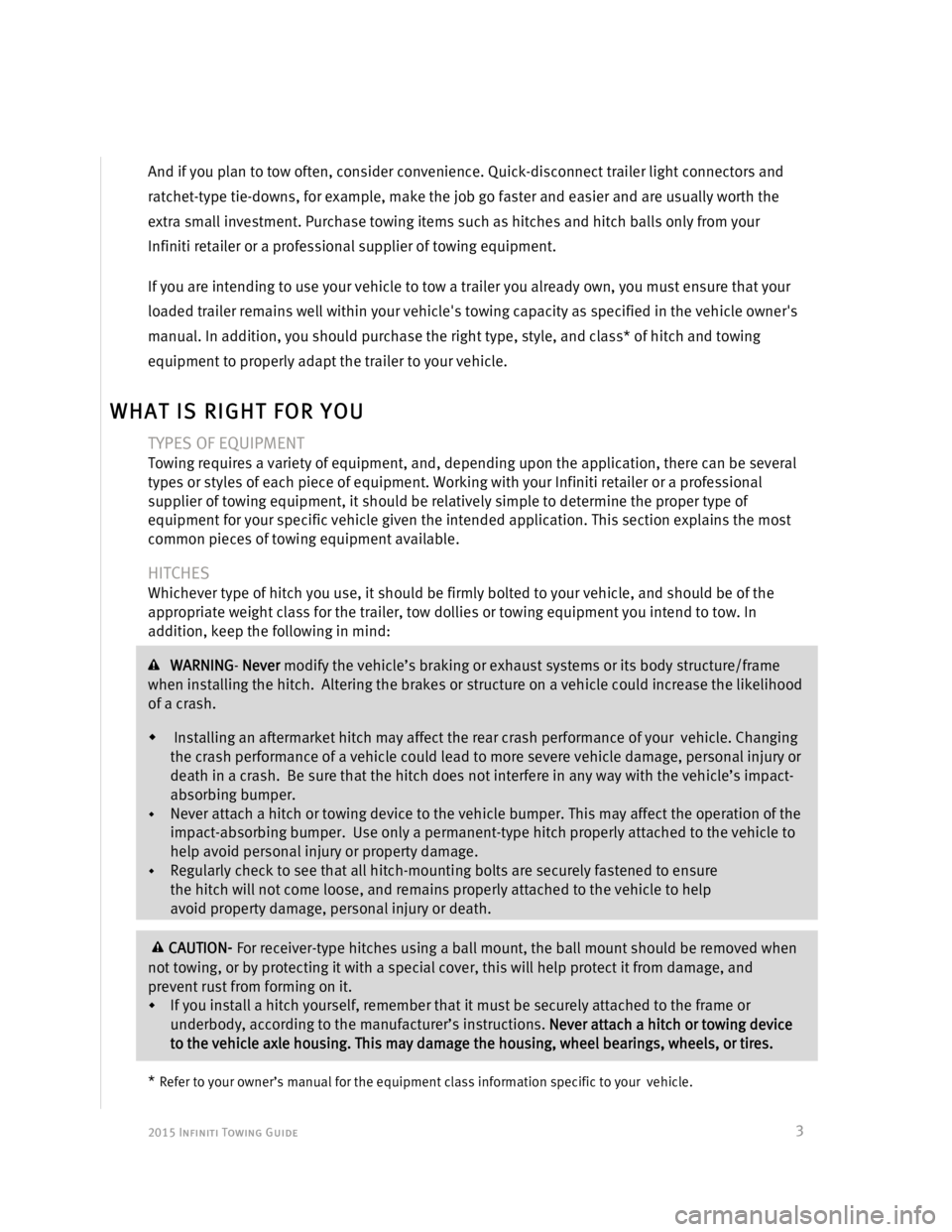
2015 Infiniti Towing Guide
3
And if you plan to tow often, consider convenience. Quick-disconnect trailer light connectors and
ratchet-type tie-downs, for example, make the job go faster and easier and are usually worth the
extra small investment. Purchase towing items such as hitches and hitch balls only from your
Infiniti retailer or a professional supplier of towing equipment.
If you are intending to use your vehicle to tow a trailer you already own, you must ensure that your
loaded trailer remains well within your vehicle's towing capacity as specified in the vehicle owner's
manual. In addition, you should purchase the right type, style, and class* of hitch and towing
equipment to properly adapt the trailer to your vehicle.
TYPES OF EQUIPMENT
Towing requires a variety of equipment, and, depending upon the application, there can be several
types or styles of each piece of equipment. Working with your Infiniti retailer or a professional
supplier of towing equipment, it should be relatively simple to determine the proper type of
equipment for your specific vehicle given the intended application. This section explains the most
common pieces of towing equipment available.
HITCHES
Whichever type of hitch you use, it should be firmly bolted to your vehicle, and should be of the
appropriate weight class for the trailer, tow dollies or towing equipment you intend to tow. In
addition, keep the following in mind:
WARNING- Never modify the vehicle’s braking or exhaust systems or its body structure/frame
when installing the hitch. Altering the brakes or structure on a vehicle could increase the likelihood
of a crash.
Installing an aftermarket hitch may affect the rear crash performance of your vehicle. Changing
the crash performance of a vehicle could lead to more severe vehicle damage, personal injury or
death in a crash. Be sure that the hitch does not interfere in any way with the vehicle’s impact-
absorbing bumper.
Never attach a hitch or towing device to the vehicle bumper. This may affect the operation of the
impact-absorbing bumper. Use only a permanent-type hitch properly attached to the vehicle to
help avoid personal injury or property damage.
Regularly check to see that all hitch-mounting bolts are securely fastened to ensure
the hitch will not come loose, and remains properly attached to the vehicle to help
avoid property damage, personal injury or death.
CAUTION- For receiver-type hitches using a ball mount, the ball mount should be removed when
not towing, or by protecting it with a special cover, this will help protect it from damage, and
prevent rust from forming on it.
If you install a hitch yourself, remember that it must be securely attached to the frame or
underbody, according to the manufacturer’s instructions. Never attach a hitch or towing device
to the vehicle axle housing. This may damage the housing, wheel bearings, wheels, or tires.
*
Refer to your owner’s manual for the equipment class information specific to your vehicle.
WHAT IS RIGHT FOR YOU
Page 5 of 25
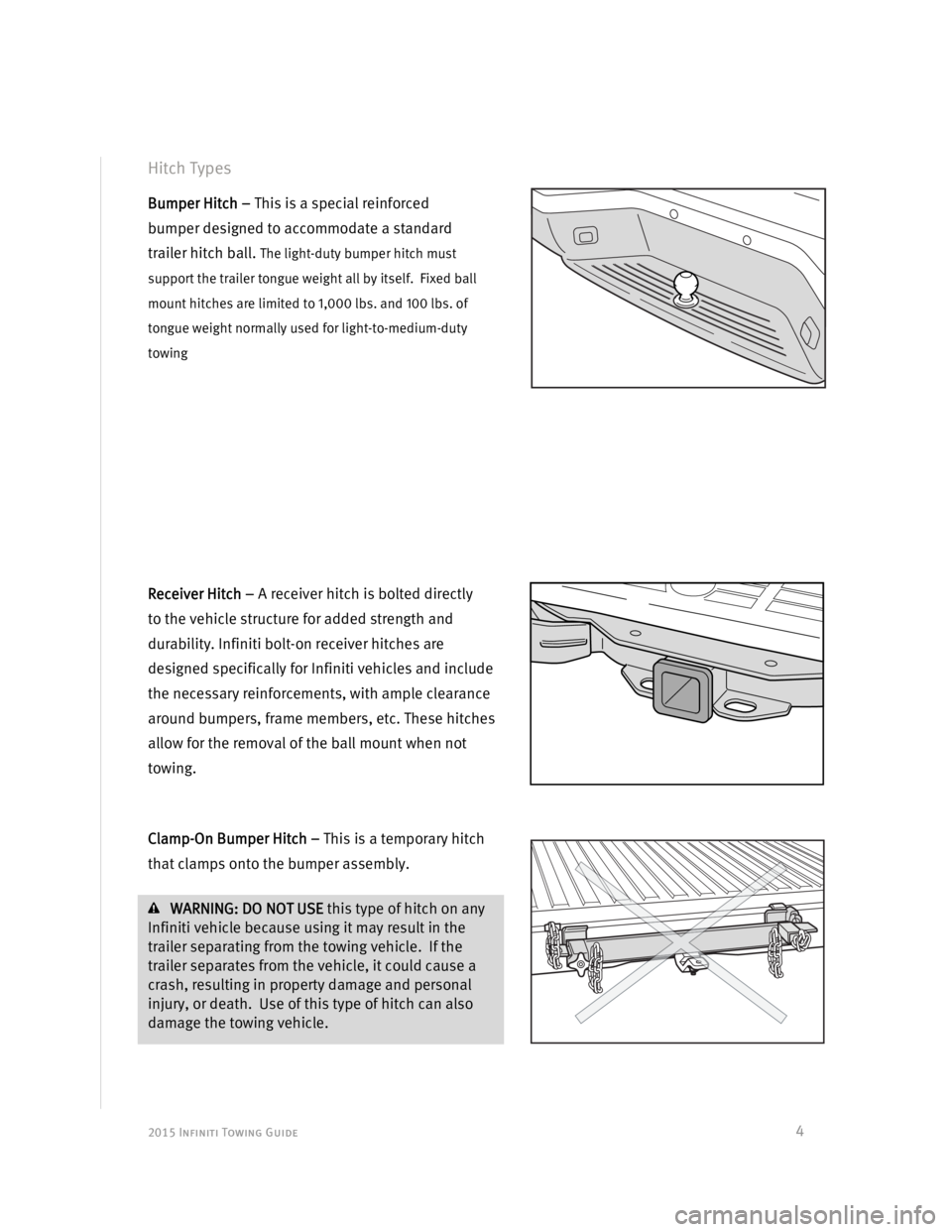
2015 Infiniti Towing Guide
4
Hitch Types
Bumper Hitch – This is a special reinforced
bumper designed to accommodate a standard
trailer hitch ball.
The light-duty bumper hitch must
support the trailer tongue weight all by itself. Fixed ball
mount hitches are limited to 1,000 lbs. and 100 lbs. of
tongue weight normally used for light-to-medium-duty
towing
Receiver Hitch – A receiver hitch is bolted directly
to the vehicle structure for added strength and
durability. Infiniti bolt-on receiver hitches are
designed specifically for Infiniti vehicles and include
the necessary reinforcements, with ample clearance
around bumpers, frame members, etc. These hitches
allow for the removal of the ball mount when not
towing.
Clamp-On Bumper Hitch – This is a temporary hitch
that clamps onto the bumper assembly.
WARNING: DO NOT USE this type of hitch on any
Infiniti vehicle because using it may result in the
trailer separating from the towing vehicle. If the
trailer separates from the vehicle, it could cause a
crash, resulting in property damage and personal
injury, or death. Use of this type of hitch can also
damage the towing vehicle.
Page 7 of 25
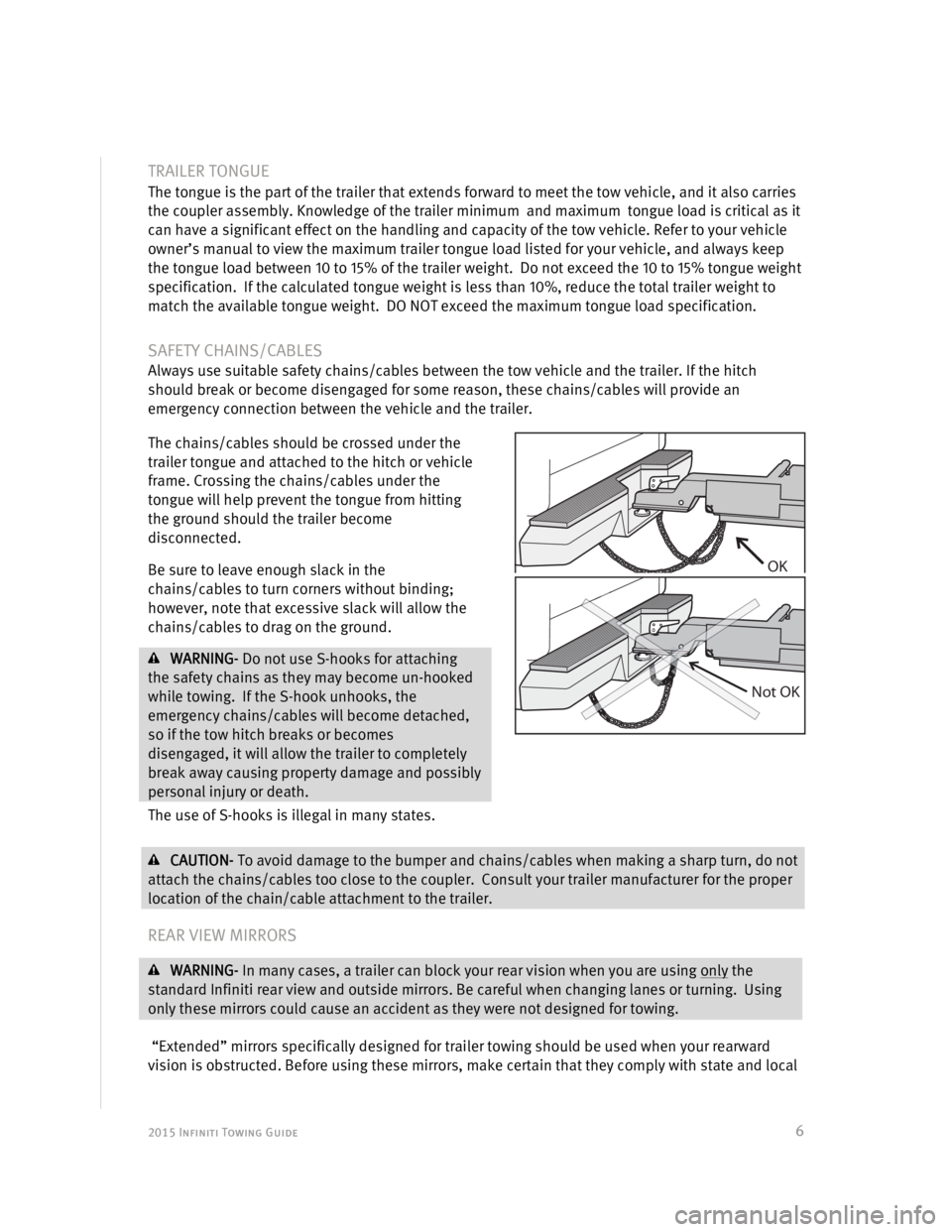
2015 Infiniti Towing Guide
6
TRAILER TONGUE
The tongue is the part of the trailer that extends forward to meet the tow vehicle, and it also carries
the coupler assembly. Knowledge of the trailer minimum and maximum tongue load is critical as it
can have a significant effect on the handling and capacity of the tow vehicle. Refer to your vehicle
owner’s manual to view the maximum trailer tongue load listed for your vehicle, and always keep
the tongue load between 10 to 15% of the trailer weight. Do not exceed the 10 to 15% tongue weight
specification. If the calculated tongue weight is less than 10%, reduce the total trailer weight to
match the available tongue weight. DO NOT exceed the maximum tongue load specification.
SAFETY CHAINS/CABLES
Always use suitable safety chains/cables between the tow vehicle and the trailer. If the hitch
should break or become disengaged for some reason, these chains/cables will provide an
emergency connection between the vehicle and the trailer.
The chains/cables should be crossed under the
trailer tongue and attached to the hitch or vehicle
frame. Crossing the chains/cables under the
tongue will help prevent the tongue from hitting
the ground should the trailer become
disconnected.
Be sure to leave enough slack in the
chains/cables to turn corners without binding;
however, note that excessive slack will allow the
chains/cables to drag on the ground.
WARNING- Do not use S-hooks for attaching
the safety chains as they may become un-hooked
while towing. If the S-hook unhooks, the
emergency chains/cables will become detached,
so if the tow hitch breaks or becomes
disengaged, it will allow the trailer to completely
break away causing property damage and possibly
personal injury or death.
The use of S-hooks is illegal in many states.
CAUTION- To avoid damage to the bumper and chains/cables when making a sharp turn, do not
attach the chains/cables too close to the coupler. Consult your trailer manufacturer for the proper
location of the chain/cable attachment to the trailer.
REAR VIEW MIRRORS
WARNING- In many cases, a trailer can block your rear vision when you are using only the
standard Infiniti rear view and outside mirrors. Be careful when changing lanes or turning. Using
only these mirrors could cause an accident as they were not designed for towing.
“Extended” mirrors specifically designed for trailer towing should be used when your rearward
vision is obstructed. Before using these mirrors, make certain that they comply with state and local
OK
Not OK
Page 11 of 25
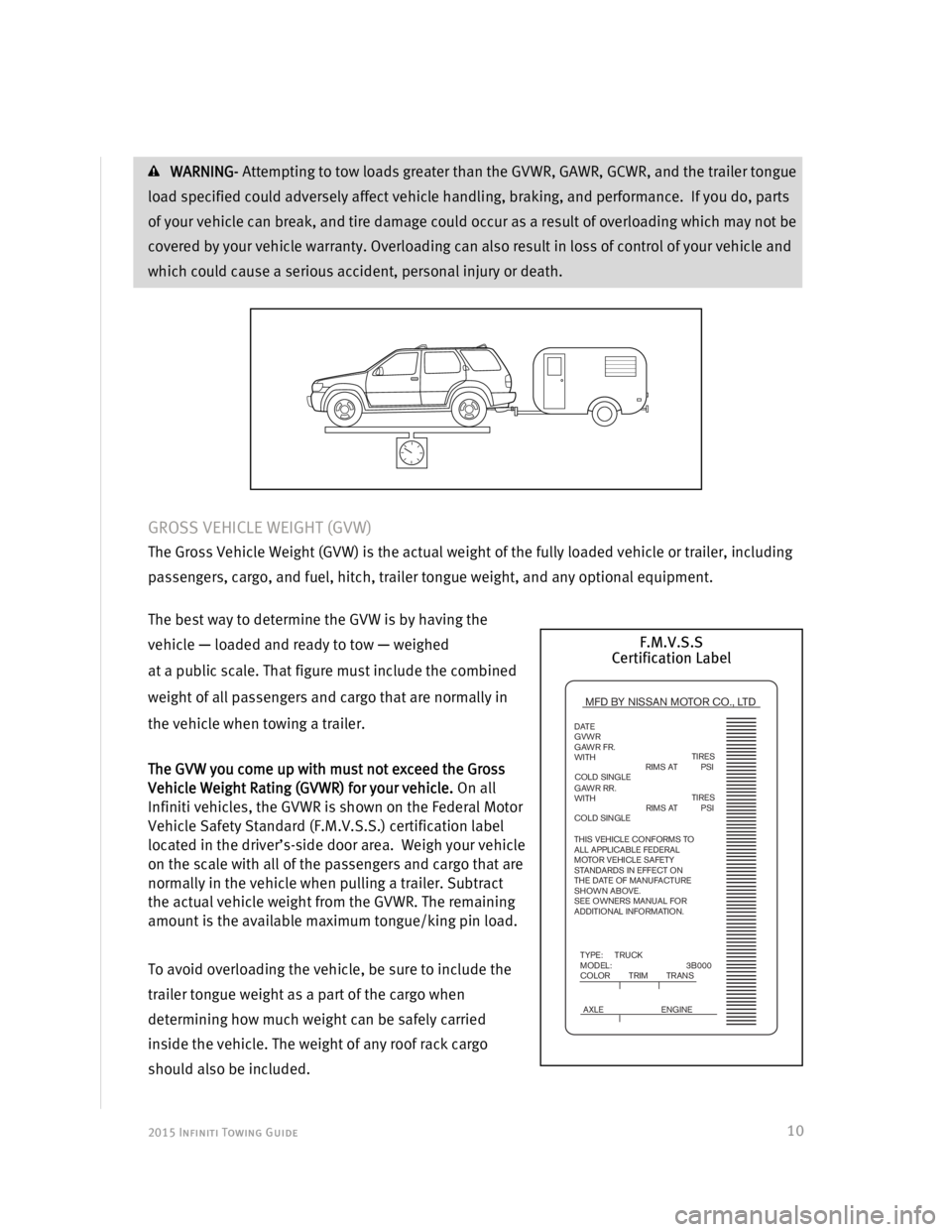
2015 Infiniti Towing Guide
10
WARNING- Attempting to tow loads greater than the GVWR, GAWR, GCWR, and the trailer tongue
load specified could adversely affect vehicle handling, braking, and performance. If you do, parts
of your vehicle can break, and tire damage could occur as a result of overloading which may not be
covered by your vehicle warranty. Overloading can also result in loss of control of your vehicle and
which could cause a serious accident, personal injury or death.
GROSS VEHICLE WEIGHT (GVW)
The Gross Vehicle Weight (GVW) is the actual weight of the fully loaded vehicle or trailer, including
passengers, cargo, and fuel, hitch, trailer tongue weight, and any optional equipment.
The best way to determine the GVW is by having the
vehicle — loaded and ready to tow — weighed
at a public scale. That figure must include the combined
weight of all passengers and cargo that are normally in
the vehicle when towing a trailer.
The GVW you come up with must not exceed the Gross
Vehicle Weight Rating (GVWR) for your vehicle. On all
Infiniti vehicles, the GVWR is shown on the Federal Motor
Vehicle Safety Standard (F.M.V.S.S.) certification label
located in the driver’s-side door area. Weigh your vehicle
on the scale with all of the passengers and cargo that are
normally in the vehicle when pulling a trailer. Subtract
the actual vehicle weight from the GVWR. The remaining
amount is the available maximum tongue/king pin load.
To avoid overloading the vehicle, be sure to include the
trailer tongue weight as a part of the cargo when
determining how much weight can be safely carried
inside the vehicle. The weight of any roof rack cargo
should also be included.
MFD BY NISSAN MOTOR CO., LTD
DATE
GVWR
GAWR FR.
WITH
GAWR RR.
WITH
THIS VEHICLE CONFORMS TO
ALL APPLICABLE FEDERAL
MOTOR VEHICLE SAFETY
STANDARDS IN EFFECT ON
THE DATE OF MANUFACTURE
SHOWN ABOVE.
SEE OWNERS MANUAL FOR
ADDITIONAL INFORMATION.
TIRES
TIRES
TYPE: TRUCK
MODEL: 3B000
COLOR TRIM TRANS
AXLE ENGINE
RIMS AT PSI
COLD SINGLERIMS AT PSI
COLD SINGLE
F.M.V.S.S
Certification Label
Page 14 of 25
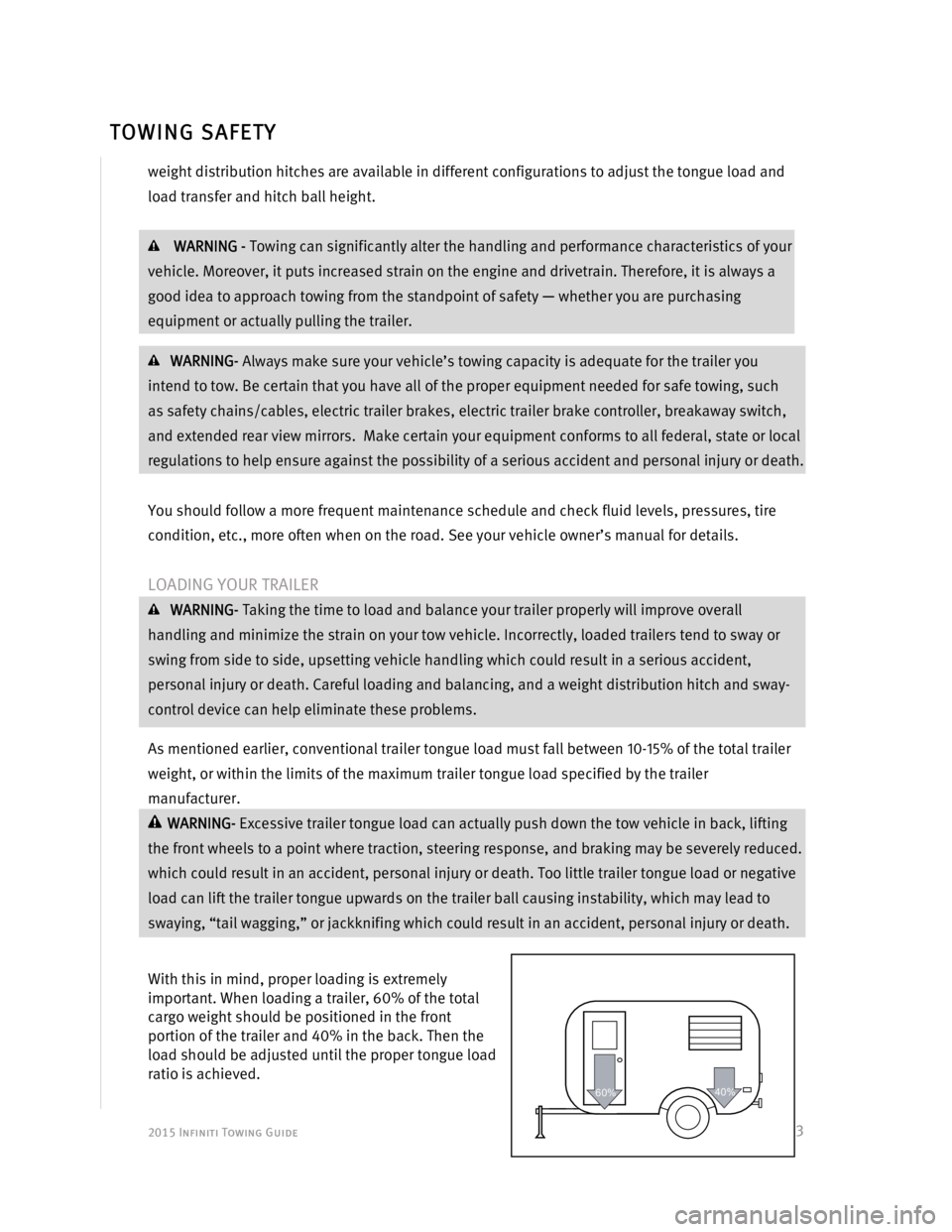
2015 Infiniti Towing Guide
13
weight distribution hitches are available in different configurations to adjust the tongue load and
load transfer and hitch ball height.
WARNING - Towing can significantly alter the handling and performance characteristics of your
vehicle. Moreover, it puts increased strain on the engine and drivetrain. Therefore, it is always a
good idea to approach towing from the standpoint of safety — whether you are purchasing
equipment or actually pulling the trailer.
WARNING- Always make sure your vehicle’s towing capacity is adequate for the trailer you
intend to tow. Be certain that you have all of the proper equipment needed for safe towing, such
as safety chains/cables, electric trailer brakes, electric trailer brake controller, breakaway switch,
and extended rear view mirrors. Make certain your equipment conforms to all federal, state or local
regulations to help ensure against the possibility of a serious accident and personal injury or death.
You should follow a more frequent maintenance schedule and check fluid levels, pressures, tire
condition, etc., more often when on the road. See your vehicle owner’s manual for details.
LOADING YOUR TRAILER
WARNING- Taking the time to load and balance your trailer properly will improve overall
handling and minimize the strain on your tow vehicle. Incorrectly, loaded trailers tend to sway or
swing from side to side, upsetting vehicle handling which could result in a serious accident,
personal injury or death. Careful loading and balancing, and a weight distribution hitch and sway-
control device can help eliminate these problems.
As mentioned earlier, conventional trailer tongue load must fall between 10-15% of the total trailer
weight, or within the limits of the maximum trailer tongue load specified by the trailer
manufacturer.
WARNING- Excessive trailer tongue load can actually push down the tow vehicle in back, lifting
the front wheels to a point where traction, steering response, and braking may be severely reduced.
which could result in an accident, personal injury or death. Too little trailer tongue load or negative
load can lift the trailer tongue upwards on the trailer ball causing instability, which may lead to
swaying, “tail wagging,” or jackknifing which could result in an accident, personal injury or death.
With this in mind, proper loading is extremely
important. When loading a trailer, 60% of the total
cargo weight should be positioned in the front
portion of the trailer and 40% in the back. Then the
load should be adjusted until the proper tongue load
ratio is achieved.
60%40%
TOWING SAFETY
Page 15 of 25

2015 Infiniti Towing Guide
14
WARNING-The trailer load should be balanced
equally from side-to-side. Unequal side-to-side
loading can negatively affect handling and
braking. Once in place, all cargo should be firmly
secured to prevent shifting. If the load should shift
abruptly during braking or cornering, it could
adversely affect the handling of your vehicle and
cause a very unsafe situation and may lead to an
accident or personal injury.
● DO NOT carry flammable materials, such as
gasoline, in your trailer. In the event of an accident,
an explosion or fire could occur.
PROVIDING FOR VEHICLE/TRAILER STABILITY
WARNING- Improper loading, excessive or insufficient trailer tongue load, overloading,
excessive trailer weight, poorly designed trailer suspensions, crosswinds, and poor maintenance
are all things that can affect the stability of your vehicle and trailer combination. Overloading or
unsafe operating conditions could lead to a serious accident, personal injury or death.
If swaying occurs, gradually reduce speed, and apply only the trailer brakes to help reduce sway.
Steady the steering wheel and gradually pull over and stop to check the cargo load for proper
balance and distribution to ensure proper trailer tongue load. In addition, check the condition of
the suspension and shocks, as well as the tires, tire pressures, and wheel bearings on both the tow
vehicle and trailer.
If the swaying continues and your trailer is suitably balanced and within the towing capacity limits
of your vehicle, discontinue towing and consult your Infiniti retailer or trailer manufacturer to
determine the problem.
VEHICLE SPEED
Please note that some states have specific regulations and speed limits for vehicles that are towing
trailers. Remember to reduce your speed in unsafe or less-than-ideal road conditions or weather.
When towing a trailer, braking distances increase while handling agility decreases. Always leave
yourself an extra margin of distance to respond to emergencies.
Page 16 of 25
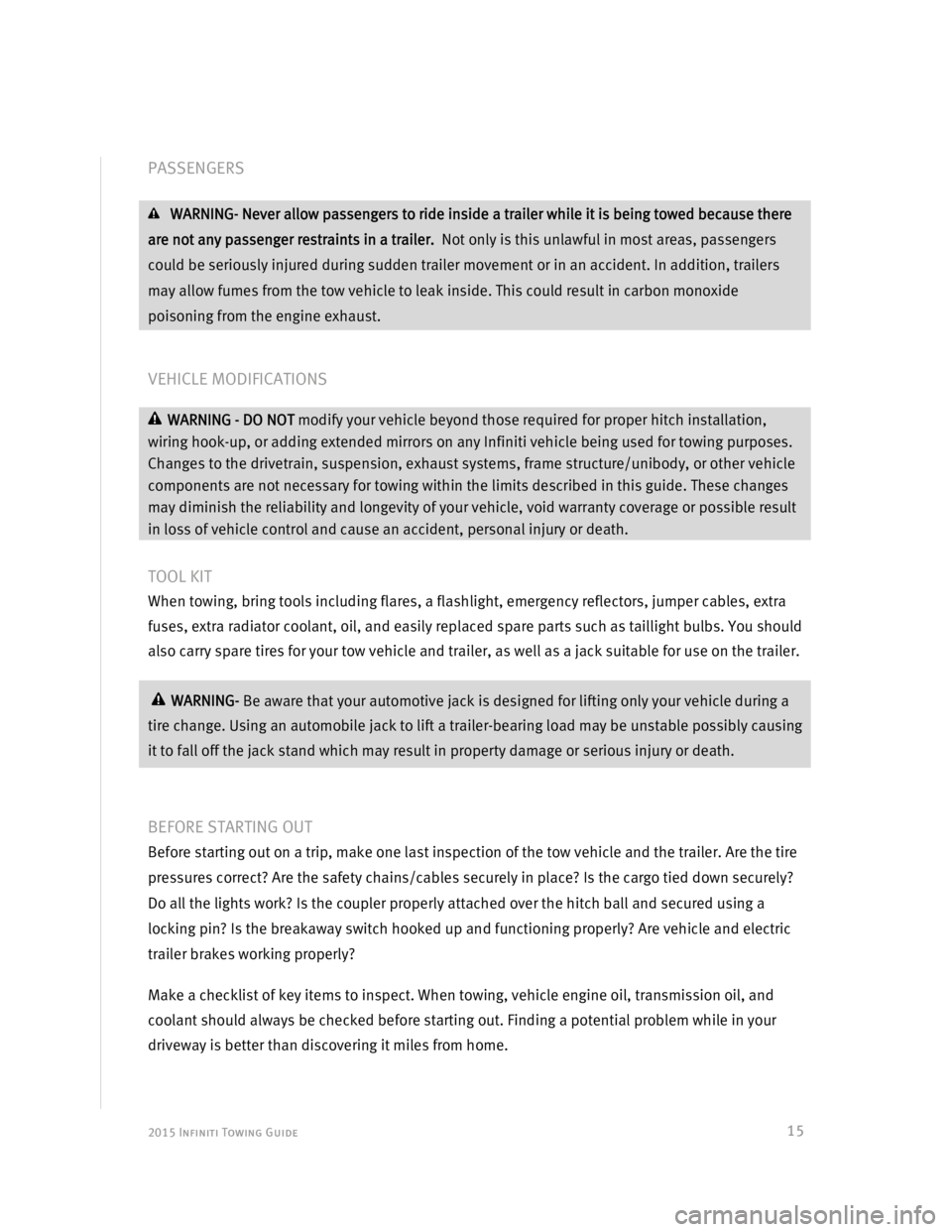
2015 Infiniti Towing Guide
15
PASSENGERS
WARNING- Never allow passengers to ride inside a trailer while it is being towed because there
are not any passenger restraints in a trailer. Not only is this unlawful in most areas, passengers
could be seriously injured during sudden trailer movement or in an accident. In addition, trailers
may allow fumes from the tow vehicle to leak inside. This could result in carbon monoxide
poisoning from the engine exhaust.
VEHICLE MODIFICATIONS
WARNING - DO NOT modify your vehicle beyond those required for proper hitch installation,
wiring hook-up, or adding extended mirrors on any Infiniti vehicle being used for towing purposes.
Changes to the drivetrain, suspension, exhaust systems, frame structure/unibody, or other vehicle
components are not necessary for towing within the limits described in this guide. These changes
may diminish the reliability and longevity of your vehicle, void warranty coverage or possible result
in loss of vehicle control and cause an accident, personal injury or death.
TOOL KIT
When towing, bring tools including flares, a flashlight, emergency reflectors, jumper cables, extra
fuses, extra radiator coolant, oil, and easily replaced spare parts such as taillight bulbs. You should
also carry spare tires for your tow vehicle and trailer, as well as a jack suitable for use on the trailer.
WARNING- Be aware that your automotive jack is designed for lifting only your vehicle during a
tire change. Using an automobile jack to lift a trailer-bearing load may be unstable possibly causing
it to fall off the jack stand which may result in property damage or serious injury or death.
BEFORE STARTING OUT
Before starting out on a trip, make one last inspection of the tow vehicle and the trailer. Are the tire
pressures correct? Are the safety chains/cables securely in place? Is the cargo tied down securely?
Do all the lights work? Is the coupler properly attached over the hitch ball and secured using a
locking pin? Is the breakaway switch hooked up and functioning properly? Are vehicle and electric
trailer brakes working properly?
Make a checklist of key items to inspect. When towing, vehicle engine oil, transmission oil, and
coolant should always be checked before starting out. Finding a potential problem while in your
driveway is better than discovering it miles from home.
Page 17 of 25
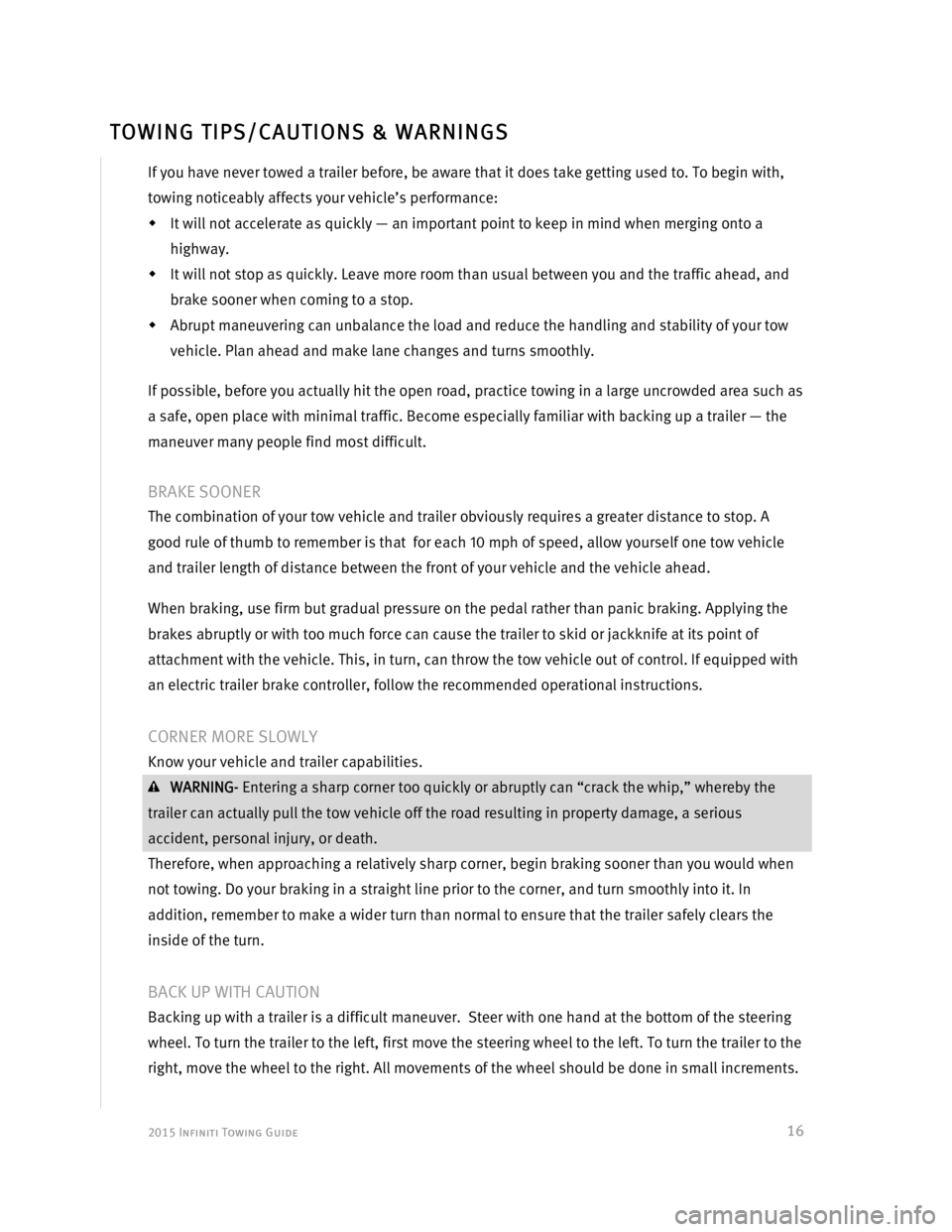
2015 Infiniti Towing Guide
16
If you have never towed a trailer before, be aware that it does take getting used to. To begin with,
towing noticeably affects your vehicle’s performance:
It will not accelerate as quickly — an important point to keep in mind when merging onto a
highway.
It will not stop as quickly. Leave more room than usual between you and the traffic ahead, and
brake sooner when coming to a stop.
Abrupt maneuvering can unbalance the load and reduce the handling and stability of your tow
vehicle. Plan ahead and make lane changes and turns smoothly.
If possible, before you actually hit the open road, practice towing in a large uncrowded area such as
a safe, open place with minimal traffic. Become especially familiar with backing up a trailer — the
maneuver many people find most difficult.
BRAKE SOONER
The combination of your tow vehicle and trailer obviously requires a greater distance to stop. A
good rule of thumb to remember is that for each 10 mph of speed, allow yourself one tow vehicle
and trailer length of distance between the front of your vehicle and the vehicle ahead.
When braking, use firm but gradual pressure on the pedal rather than panic braking. Applying the
brakes abruptly or with too much force can cause the trailer to skid or jackknife at its point of
attachment with the vehicle. This, in turn, can throw the tow vehicle out of control. If equipped with
an electric trailer brake controller, follow the recommended operational instructions.
CORNER MORE SLOWLY
Know your vehicle and trailer capabilities.
WARNING- Entering a sharp corner too quickly or abruptly can “crack the whip,” whereby the
trailer can actually pull the tow vehicle off the road resulting in property damage, a serious
accident, personal injury, or death.
Therefore, when approaching a relatively sharp corner, begin braking sooner than you would when
not towing. Do your braking in a straight line prior to the corner, and turn smoothly into it. In
addition, remember to make a wider turn than normal to ensure that the trailer safely clears the
inside of the turn.
BACK UP WITH CAUTION
Backing up with a trailer is a difficult maneuver. Steer with one hand at the bottom of the steering
wheel. To turn the trailer to the left, first move the steering wheel to the left. To turn the trailer to the
right, move the wheel to the right. All movements of the wheel should be done in small increments.
TOWING TIPS/CAUTIONS & WARNINGS